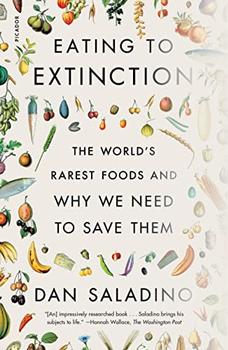Summary | Excerpt | Reviews | Read-Alikes | Genres & Themes | Author Bio

Weaving fascinating anecdotes and accessible science into gorgeous prose, Pollan takes us on an absorbing journey that will change the way we think about our place in nature.
In 1637, one Dutchman paid as much for a single tulip bulb as the going price of a town house in Amsterdam. Three and a half centuries later, Amsterdam is once again the mecca for people who care passionately about one particular plant -- though this time the obsessions revolves around the intoxicating effects of marijuana rather than the visual beauty of the tulip. How could flowers, of all things, become such objects of desire that they can drive men to financial ruin?
In The Botany of Desire, Michael Pollan argues that the answer lies at the heart of the intimately reciprocal relationship between people and plants. In telling the stories of four familiar plant species that are deeply woven into the fabric of our lives, Pollan illustrates how they evolved to satisfy humankinds's most basic yearnings -- and by doing so made themselves indispensable. For, just as we've benefited from these plants, the plants, in the grand co-evolutionary scheme that Pollan evokes so brilliantly, have done well by us. The sweetness of apples, for example, induced the early Americans to spread the species, giving the tree a whole new continent in which to blossom. So who is really domesticating whom?
Weaving fascinating anecdotes and accessible science into gorgeous prose, Pollan takes us on an absorbing journey that will change the way we think about our place in nature.
 Alice Waters
Michael Pollan is a sensualist and a wonderful, funny storyteller. He is so engaging that his profound environmental messages are effortlessly communicated. He makes you fall in love with Nature.
Alice Waters
Michael Pollan is a sensualist and a wonderful, funny storyteller. He is so engaging that his profound environmental messages are effortlessly communicated. He makes you fall in love with Nature. Betty Fussell, author of My Kitchen Wars
Anyone who has ever made personal contact with an apple, spud, tulip, or marijuana bud should read this book and be astonished at the eternal tango of men and plants, choreographed with wit, daring, and humanity by this botanist of desire who knows equally the power of plants and of words.
Betty Fussell, author of My Kitchen Wars
Anyone who has ever made personal contact with an apple, spud, tulip, or marijuana bud should read this book and be astonished at the eternal tango of men and plants, choreographed with wit, daring, and humanity by this botanist of desire who knows equally the power of plants and of words. Bill McKibben, author of Long Distance and The End of Nature
This book is as crisp as an October apple, as juicy as an August tomato, as long-awaited as the first flower of spring,. Michael Pollan has conceived a new and powerful understanding of who we are, and how we stand in relation to everything else--and the stories he tells to prove the point make the world seem a richer place.
Bill McKibben, author of Long Distance and The End of Nature
This book is as crisp as an October apple, as juicy as an August tomato, as long-awaited as the first flower of spring,. Michael Pollan has conceived a new and powerful understanding of who we are, and how we stand in relation to everything else--and the stories he tells to prove the point make the world seem a richer place. Richard Ford
I find this book to be inspirational -- curiosity and gentleness of spirit forming genius.
Richard Ford
I find this book to be inspirational -- curiosity and gentleness of spirit forming genius. William Cronon, editor of Uncommon Ground Rethinking the Human Place in Nature
No one else writes about the human environment quite like Michael Pollan we can be grateful indeed that one of our wittiest writers about nature is also one of our wisest. In The Botany of Desire, Pollan makes a persuasive case that the plants we might be tempted to see as having been most domesticated by humanity are in fact also those that have been most effective in domesticating us. It is a stunning insight, and no one will come away from this book without having their ideas of nature stretched and challenged.
William Cronon, editor of Uncommon Ground Rethinking the Human Place in Nature
No one else writes about the human environment quite like Michael Pollan we can be grateful indeed that one of our wittiest writers about nature is also one of our wisest. In The Botany of Desire, Pollan makes a persuasive case that the plants we might be tempted to see as having been most domesticated by humanity are in fact also those that have been most effective in domesticating us. It is a stunning insight, and no one will come away from this book without having their ideas of nature stretched and challenged.

If you liked The Botany of Desire, try these:

by Dan Saladino
Published 2023
Dan Saladino's Eating to Extinction is the prominent broadcaster's pathbreaking tour of the world's vanishing foods and his argument for why they matter now more than ever.

by Ruth Kassinger
Published 2015
In the tradition of The Botany of Desire and Wicked Plants, a witty and engaging history of the first botanists interwoven with stories of today's extraordinary plants found in the garden and the lab.